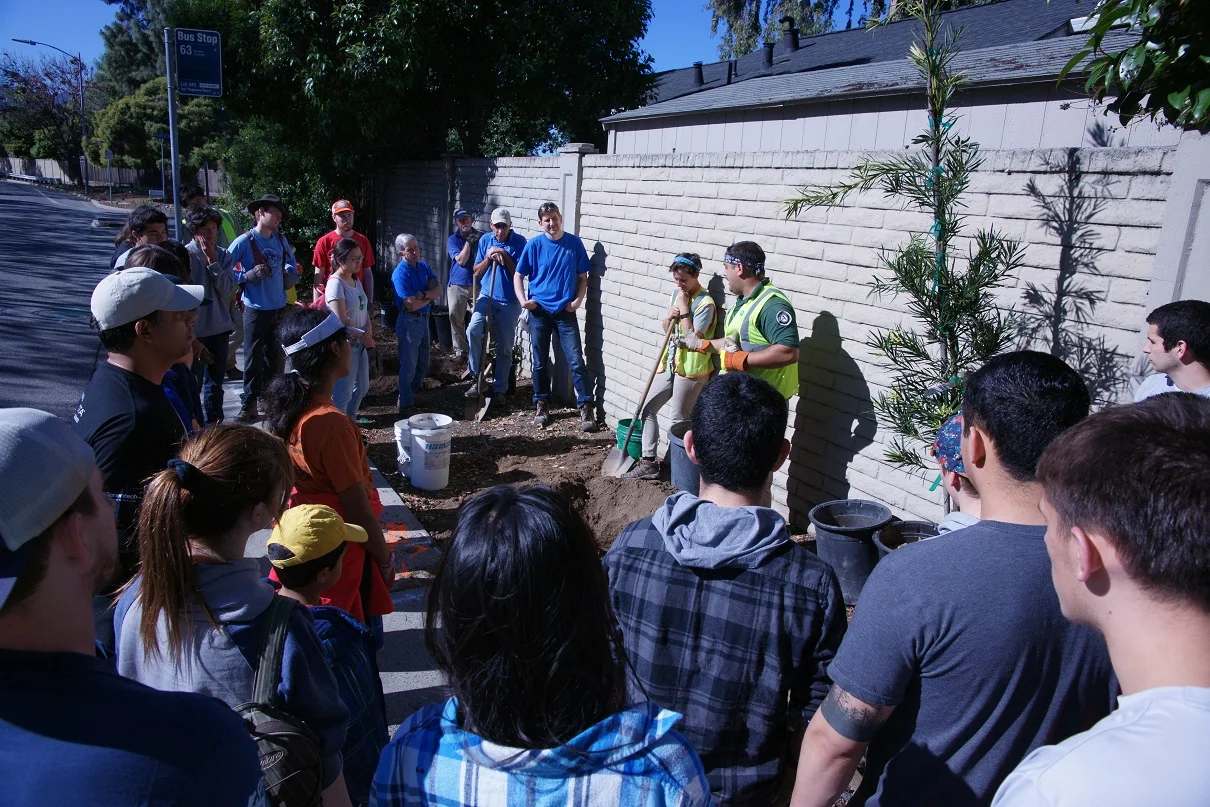We lost 23 trees last week. They were saplings, planted only months ago. They were yew pines, chinese fringes. Their holes were dug by more than one hundred volunteers and led by AmeriCorps members. They were bought with money provided by San Jose, by Councilman Pierluigi Oliverio. They were grown in our nursery, tended to by our volunteers, by school groups and dedicated AmeriCorps members. These trees took time, effort and cooperation to raise. They took money, community investment and muscle to put into the ground. They took dedication to tend on our weekly watering runs. In a way, these trees were representations of us, as a community. If they had been allowed to continue growing they would have provided shade, flowers and air-cleaning to a hot and busy street.
Like this, only on a busier road.
All of our trees on Meridian were cut like this.
In a wild, rural forest we don’t think about these things. We don’t plant every tree. We don’t prune them, shape them, to thrive in the urban landscape. A rural forest might have caretakers, but rarely are individual trees given consideration. A rural forest provides ecosystem services, like cleaning watersheds or preventing landslides, or providing habitat but these things are abstract compared to the concrete experience of relaxing in the shade, plucking an orange from a low branch or seeing trees bloom. The investment, the time, the care and attachment to individual trees makes an urban forest different from a rural forest.
Ideally, urban forests would be carefully managed by a single office. All too often this is not the case. In San Jose, we have a City Arborist, Caltrans, PG&E, the DOT and the Park’s Department. They all manage aspects of the urban forest. It’s difficult to find out who has jurisdiction over any particular tree. Sometimes it’s more than one. Of course that doesn’t factor in property owners, managers, renters and tree-care companies. Toss in us, Our City Forest, a do-gooder nonprofit for flavor. The landscape is complicated.
Urban forestry is a group effort. You can see the cut trees still in their pots the morning we planted them.
The life of a tree, such as it is, is much more difficult in an urban setting. The soil is disrupted, compacted and often devoid of a stable group of microbial symbionts. The air is polluted, not every tree can handle prolonged exposure to car exhaust. The land is hotter because of the way that concrete and asphalt absorb and radiate heat. The ground is drier because compacted, heated soil holds less water, while drought-conscious people choose not to water their trees. When you think about the various agencies and people in play it gets harder.
Given this, it shouldn’t be a surprise that the most common causes of tree death in an urban landscape are human-related. Trees tend not to live terribly long in cities, an average of 7-19 years. 19 years is nothing for some species of tree, a coast-live can live for a millennium. Even the short-lived crape myrtle lives roughly 30 years. At any point a vandal with an axe to grind, a bored kid, a careless motorist, a construction crew, fireworks or a uninformed homeowner can injure or end a tree’s life. People tend not to think about trees until something happens to them. They’re set dressings or background. It’s only when a tree falls, is bug-bitten, drops its leaves, or breaks that people pay attention.
That’s really what we need from you, our readers and fellow tree people. We need you to pay attention. We need you to help plant and care for trees, sure but it’s just as important that you push for positive change. We need you to be invested in the regulations around trees. We need you to help clarify their legal status, enhance the funding for trees in the city. We need you to advocate for trees. We need you to monitor trees for invasive pests. We need you to recognize which trees are helpful for this area.
I’d like to think that this blog has helped do this in some small way. I hope that the loss of our 23 trees helps galvanize your investment in urban trees. If you want to volunteer, donate or possibly work for us this is the right time. Please join us in growing our urban forest.




